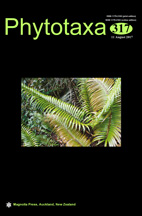Abstract
Within Astraea Klotzsch (1841: 194), Astraea lobata (Linnaeus 1753: 1005) Klotzsch (1841: 194) may be considered the most taxonomically complex species due to its wide geographical distribution and the several varieties that have been proposed for this species by Müller Argoviensis (1866, 1874). In his concept, Müller Argoviensis (1866) united under Croton lobatus Linnaeus (1753: 1005) plants with 3–5-partite leaves almost as long as the petioles, subulate stipules, the bracts not well developed and ovaries with varied indumentum. In De Candolles’s Prodromus, Müller Argoviensis (1866) recognized eight varieties, maintaining this concept in the Flora Brasiliensis (Müller Argoviensis 1874) with few modifications. Morphological characters and geographical distribution support the recognition of some of these varieties as species distinct from A. lobata. As part of an undergoing taxonomic revision of Astraea, these distinct taxa must be validly published for further studies on this genus. Therefore, in this note we propose these novelties with commentaries about morphology and geographic distribution, along with photos to illustrate them and lectotypifications when necessary.

